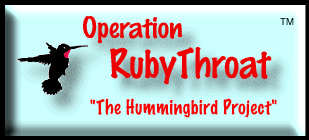|
|
|||
|
All text & photos © Hilton Pond Center Shortly after friend and garden writer Nancy Brachey included a nice note about our winter hummingbird work in the 21 February 2003 issue of The Charlotte Observer, we received several E-mails about previously unreported vagrant hummers in the Carolinas. Although of those reports arrived while we were away from Hilton Pond Center in Costa Rica on 19-22 Feb, we contacted each homeowner upon our return and learned that the birds were still present. Unfortunately, we had to turn right around and go to Iowa for five days, so it wasn't until the first week in March that were able to start investigating all the reports. Even had we not gone to Iowa, however, we likely couldn't have banded any hummingbirds, since a record snowfall of up to 18" blanketed the Carolina Upstate on 25-27 Feb and made travel impossible.
Our first road trip in response to the E-mails came on 2 March, when our destination was Cheraw SC in Chesterfield County, about two hours from our home base in York SC. We had heard from Sarah Ann and Rock Thompson, who reported hummingbirds had been at their feeders more or less continuously since January 2003; in other words, for two consecutive winters the Thompsons have had hummers whose presence overlapped Ruby-throated Hummingbirds that would be expected from April through October. Sarah Ann believed she had more than one hummer in the current winter of 2003-2004--perhaps as many as three or four, including a "large grayish one" that pushed aside snow on the feeder port during last week's storm.
Following our usual plan, we departed Hilton Pond in time to arrive at Cheraw before sunrise. This late in the year, that meant we wanted to have our trap hanging not later than 6:40 a.m. and to have placed the Thompsons' feeder inside it as bait. Things worked according to plan, and we went into the house to stand watch for the first hummingbird of the morning. Within three minutes a bird zipped by the trap without stopping, only to pass by in the other direction a few minutes later. Then, at 6:58 a.m. a hummer flew to the trap and tried to get at the feeder through the wire mesh. After trying for another minute or two, the bird figured out the open trapdoor and entered to feed. Quickly we flipped the switch on our wireless transmitter and the servo motor that operates the trap made the door slide shut.
As we went back outside to retrieve our new capture, we noticed that the hummer's throat bore several metallic orange-red feathers, and its flanks were quite rusty. Because the bird was molting the outer four pairs of tail feathers, it was difficult to see if the hummer had a rusty base to its tail--a characteristic that would have ruled out its being a Ruby-throat. After we banded the bird and jotted a few more motes, we took our usual set of photographs and Now that Sarah Ann and Rock know about our winter hummingbird work, they've promised to let us know as soon as any vagrants appear in the fall of 2004. And now that we know the way to their place in Cheraw we plan on going back to see just what's going on with all these winter hummers in the Thompson backyard. Vital Statistics for All text & photos © Hilton Pond Center
If you're interested in sharing your hummingbird observations and learning from other enthusiasts, you may wish to subscribe to Hummingbird Hobnob, our Yahoo!-based discussion group. Also be sure to visit our award-winning Web site for Operation RubyThroat: The Hummingbird Project; on it you'll find almost anything you want to know about hummingbirds, including more information about Hummingbird Banding.
For much more information about hummingbirds, visit: |
|
Make direct donations on-line through
Network for Good: |
|
|
LIKE TO SHOP ON-LINE?
Donate a portion of your purchase price from 500+ top on-line stores via iGive: |
|
|
Use your PayPal account
to make direct donations: |
|
|
Back to Vagrant & Winter Hummingbird Banding Back to This Week at Hilton Pond Back to What's New? Current Weather Conditions at Hilton Pond Center |
|
Join the |
|
post questions for The Piedmont Naturalist |
Join the |
Search Engine for |
|
|

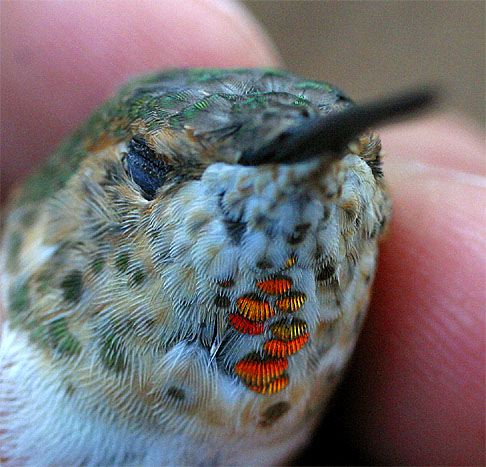
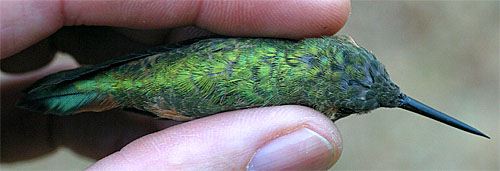
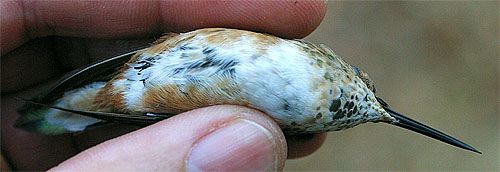

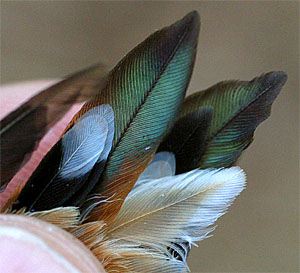 Since there were metallic gorget feathers and the bird's back and head were completely green, we suspected it was a female Rufous Hummingbird, Selasphorus rufus, reserving final judgment until the requisite measurements were made (see below). A closer examination over the kitchen table showed the bird was too big to be either the similarly colored Allen's Hummingbird, S. sasin, or a young male Rufous--which also would be smaller than a female Rufous. We examined the bird closely for additional molt and found that the next to last primary wing feather had not quite completed its growth. Interestingly, the bird's upper and lower eyelids--which normally are lightly feathered at least along the edges--were completely bare (below right).
Since there were metallic gorget feathers and the bird's back and head were completely green, we suspected it was a female Rufous Hummingbird, Selasphorus rufus, reserving final judgment until the requisite measurements were made (see below). A closer examination over the kitchen table showed the bird was too big to be either the similarly colored Allen's Hummingbird, S. sasin, or a young male Rufous--which also would be smaller than a female Rufous. We examined the bird closely for additional molt and found that the next to last primary wing feather had not quite completed its growth. Interestingly, the bird's upper and lower eyelids--which normally are lightly feathered at least along the edges--were completely bare (below right).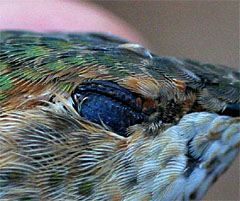 asked Sarah Ann to release the bird. We then went back inside to await the arrival of additional hummers but saw none in the next 90 minutes. We suspect unseasonably warm temperatures--it was already 65 degrees by 9 a.m.--meant any hummer in the neighborhood was feasting on tiny insects rather than sugar water, and it's entirely possible that other hummingbirds in the area had already departed on their way back to their breeding grounds. Most winter vagrant hummers seem to do just that starting as early as February, so we wouldn't be surprised if the bird we had just banded at the Thompsons' moved out within a day or two.
asked Sarah Ann to release the bird. We then went back inside to await the arrival of additional hummers but saw none in the next 90 minutes. We suspect unseasonably warm temperatures--it was already 65 degrees by 9 a.m.--meant any hummer in the neighborhood was feasting on tiny insects rather than sugar water, and it's entirely possible that other hummingbirds in the area had already departed on their way back to their breeding grounds. Most winter vagrant hummers seem to do just that starting as early as February, so we wouldn't be surprised if the bird we had just banded at the Thompsons' moved out within a day or two.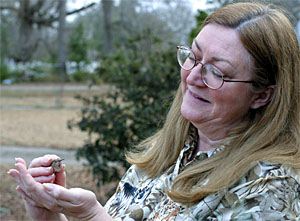
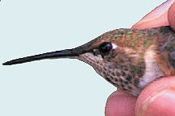
 Students at GLOBE-certified schools may submit winter hummingbird observations as part of Operation RubyThroat and GLOBE. Students can also correlate hummingbird observations with data on abiotic factors, including atmosphere, climate, hydrology, soils, land cover, and phenology. See the
Students at GLOBE-certified schools may submit winter hummingbird observations as part of Operation RubyThroat and GLOBE. Students can also correlate hummingbird observations with data on abiotic factors, including atmosphere, climate, hydrology, soils, land cover, and phenology. See the 